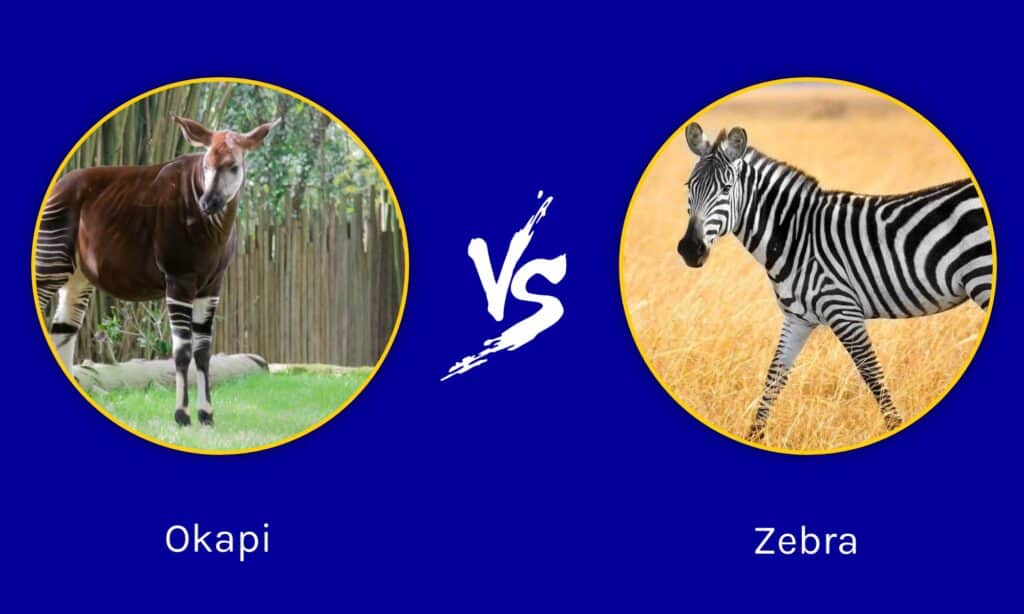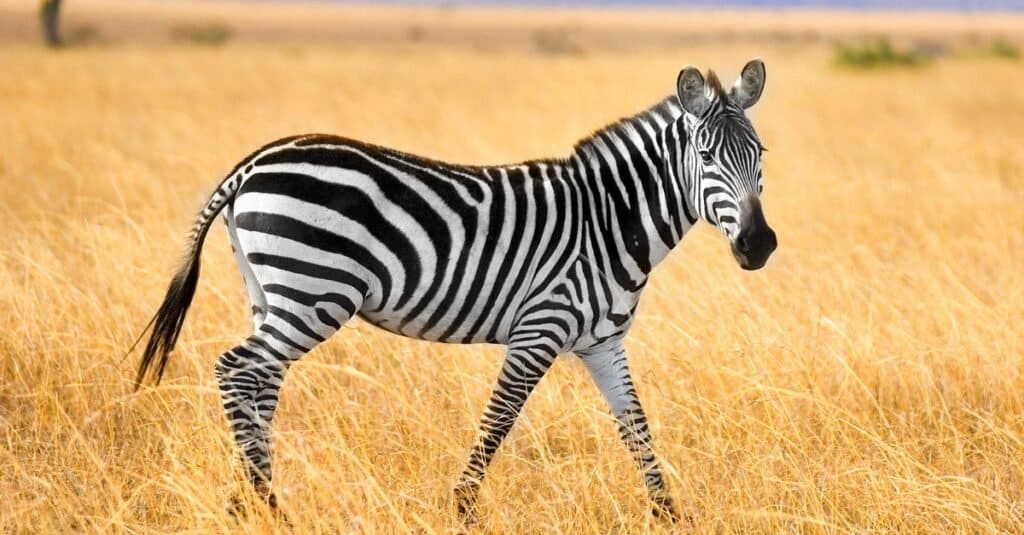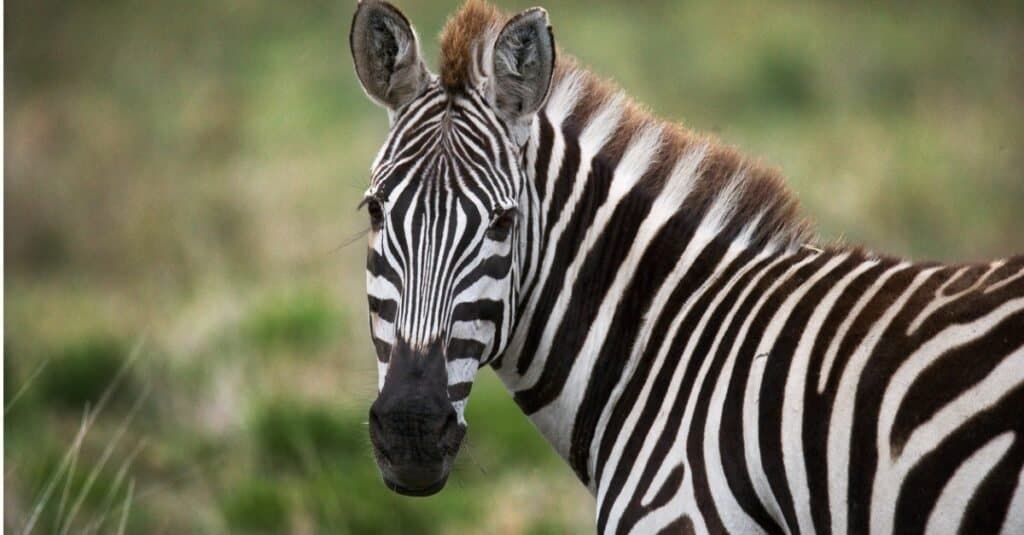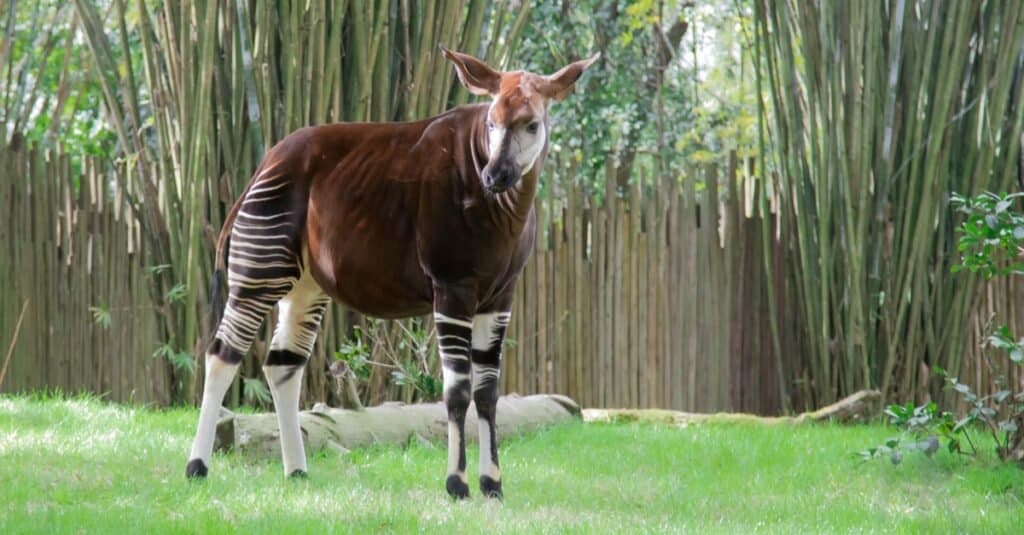The okapi is a rare animal found in a small part of the tropical forests in Central Africa. They are herbivorous, with long necks relative to their body and horizontal stripes on their hindquarters that make them look zebra-like. They also look like deer, but they are actually surviving ancestors of giraffes. Their scientific name is Okapi johnstoni.
Zebras are large, heavy-bodied animals with distinct black and white stripes that let them distinguish one another in the herd. Zebras inhabit the open grasslands and plains of East and Southern Africa, where they spend most of their time grazing on the grass.
Three different species of zebra are found in Africa: the common zebra (also known as the plains zebra and the Burchell’s zebra), the Grevy’s zebra (also known as the imperial zebra), and the mountain zebra.
There are differences between the okapi and the zebra, no matter how much they have in common. Let us compare both animals to see how we can know them more distinctly.
Comparing Okapis vs Zebras

| Okapi | Zebra | |
|---|---|---|
| Height | 4.9ft – 6.5ft | 6.6ft – 9ft |
| Weight | 440lbs – 660lbs | 485lbs – 893lbs |
| Appearance | red-brown colored coat of fur with horizontal, white striped markings | Brown, Black, White Skin coat with Hair |
| Habitat | Dense mountain forest | Open grassland and plains |
| Predators | Leopard, Serval, Human | Lions, Leopards, Hyenas, African Wild Dogs |
| Prey | Leaves, shoots, fruits | Grasses, Leaves, Buds |
| Reproduction | Gestational (15 months) | Gestational (10-12 months) |
| Diets | Herbivore | Herbivore |
| Lifespan | 20 – 30 years | 20 – 30 years |
The Key Differences Between Okapis and Zebras
The key differences between okapis and zebras are size, appearance, habitat, predators, diet, and behavior.
Let’s explore these differences in detail!
Okapi vs. Zebra: Weight and Height

Okapi weighs between 440 and 660 pounds.
©Jiri Hrebicek/Shutterstock.com
Okapis weigh less than zebras, and they are smaller as well. An okapi’s height is about 4.9 ft to 6.5 ft, while a zebra’s height is between 6.6 ft and 9 ft. Where an okapi weighs between 440 and 660 pounds, a zebra weighs between 485 and 893 pounds.
Simply, a zebra is a heavier and bigger animal than the okapi.
Okapi vs. Zebra: Appearance

The zebra has a mane that extends from its forehead and back to the tail.
©iStock.com/GlobalP
The okapi is a strange animal in terms of its appearance. It has a long neck like its ancestors, which it uses to reach leaves and protect itself. They have a reddish-brown-colored coat of fur with horizontal white stripes on their hindquarters and at the tops of their legs. The skin provides excellent camouflage in the dense jungle. Its long head, dark muzzle, and large ears allow the okapi to detect prey easily. They have white ankles with a dark spot above each hoof and very thick skin to help protect them from injury.
Zebras’ bodies are perfectly designed for speed, with their long, slender legs and narrow hooves, reaching speeds of 40 kph when running. Their black and white stripes are unique to each individual and help identify each other when in the herd. They have long necks and heads that allow them to quickly reach the grass on the ground. The zebra has a mane that extends from its forehead and back to the tail.
The stripe print varies between the species, with Grevy’s and Mountain Zebras having narrower stripes and white undersides, while the common zebra has broad stripes covering its entire body. The Grevy’s zebra is not only the largest of the zebra species but is also easily identifiable by its large, rounded ears.
Okapi vs. Zebra: Habitat and Distribution
Okapis inhabit the dense tropical rainforests of the north-eastern Democratic Republic of Congo, usually at an altitude of between 500 and 1,000 meters. They are shy and rare animals that rely heavily on the thick foliage around them to hide them from predators. Okapis can also be found in areas with a slow-moving freshwater source.
Zebras are usually found in the open grasslands and plains of East and Southern Africa, where they spend most of their time grazing on the grass. The common zebra (Equus quagga) has the largest population and the most comprehensive natural range throughout East Africa, where they roam the grassy plains. The mountain zebra (Equus zebra) usually grazes on the mountain grasslands of South-West Africa. At the same time, the Grevy’s zebra (Equus grevyi) is confined to the arid plains and sub-desert steppe throughout Ethiopia, Somalia, and northern Kenya.
Okapi vs. Zebra: Predators and Threats

Zebras are preyed upon by lions, leopards, hyenas, African wild dogs, and numerous other large carnivores.
©GUDKOV ANDREY/Shutterstock.com
The leopard primarily threatens the okapi. The Leopard’s stealth ability renders the acute hearing of the okapi unable to detect above-the-ground movements of the leopard. Other threats, however, are the serval and human hunters. The okapi’s population is also threatened by deforestation and loss of habitat.
The zebra is a large and powerful animal that can easily outrun many of its predators despite being herbivorous. Zebras are preyed upon by lions, leopards, hyenas, African wild dogs, and numerous other large carnivores, such as crocodiles. Although their first instinct is to run away, zebras sometimes attack and threaten the animal by kicking and biting. When they spot danger, zebras alert one another of the threat and move away from their predator as a closed herd, which either confuses or intimidates their attacker. Human activity’s increasing encroachment on their natural habitats is the primary threat to Africa’s remaining zebra populations.
Okapi vs Zebra: Prey and Diet

The okapi eats more than 100 different plants, many of which are poisonous to other animals and humans.
©seth miles/Shutterstock.com
The okapi is herbivorous – it survives on a diet of only plant matter. They eat leaves, shoots, and twigs. The okapi eats more than 100 different plants, many of which are poisonous to other animals and humans. Aside from plants, they sometimes eat fungi and reddish clay that gives them the salt and minerals they need.
The zebra’s diet consists of a wide variety of grasses, with other plant matter, including leaves and buds, making up the rest. Common zebras drink at water holes every day. The Grevy’s and Mountain zebra inhabit drier, more arid regions, so they often don’t drink for several days at a time. In the dry season, zebras travel vast distances searching for fresh grass and water holes that haven’t dried up.
Okapi vs. Zebra: Behavior
The okapi lives solitary lifestyles except when mothers spend time with their calves. They can tolerate other individuals and may often feed together in small groups for short periods. Okapi males fight one another with their necks to settle disputes over territory and female mates during the breeding season. Okapis also communicate with one another using quiet “chuff” sounds. When their environment does not allow them to see well enough, they rely heavily on their acute sense of hearing to detect danger.
Zebras are sociable animals that roam the savanna in herds for protection from predators. Their solid social bonds make them very affectionate, and they groom each other with their teeth. During the mating season, males will fight fiercely for the right to breed with the females, and they do so by rearing up on their back legs while kicking and biting one another.
The photo featured at the top of this post is © slowmotiongli/Shutterstock.com
Thank you for reading! Have some feedback for us? Contact the AZ Animals editorial team.






